C++——Inheritence
一种错误的观念:
子类继承父类,只把父类的公有成员继承下来,私有的不会继承。
事实上无论是如何继承,都会把父类的所有成员继承下来。
#include<iostream>
using namespace std; class Base {
private:
int x;
}; class D :private Base{
public:
int y;
}; int main()
{
cout << sizeof(Base) << endl;
cout << sizeof(D) << endl;
return ;
}
输出结果:4 8
继承关系要看2点,见下图
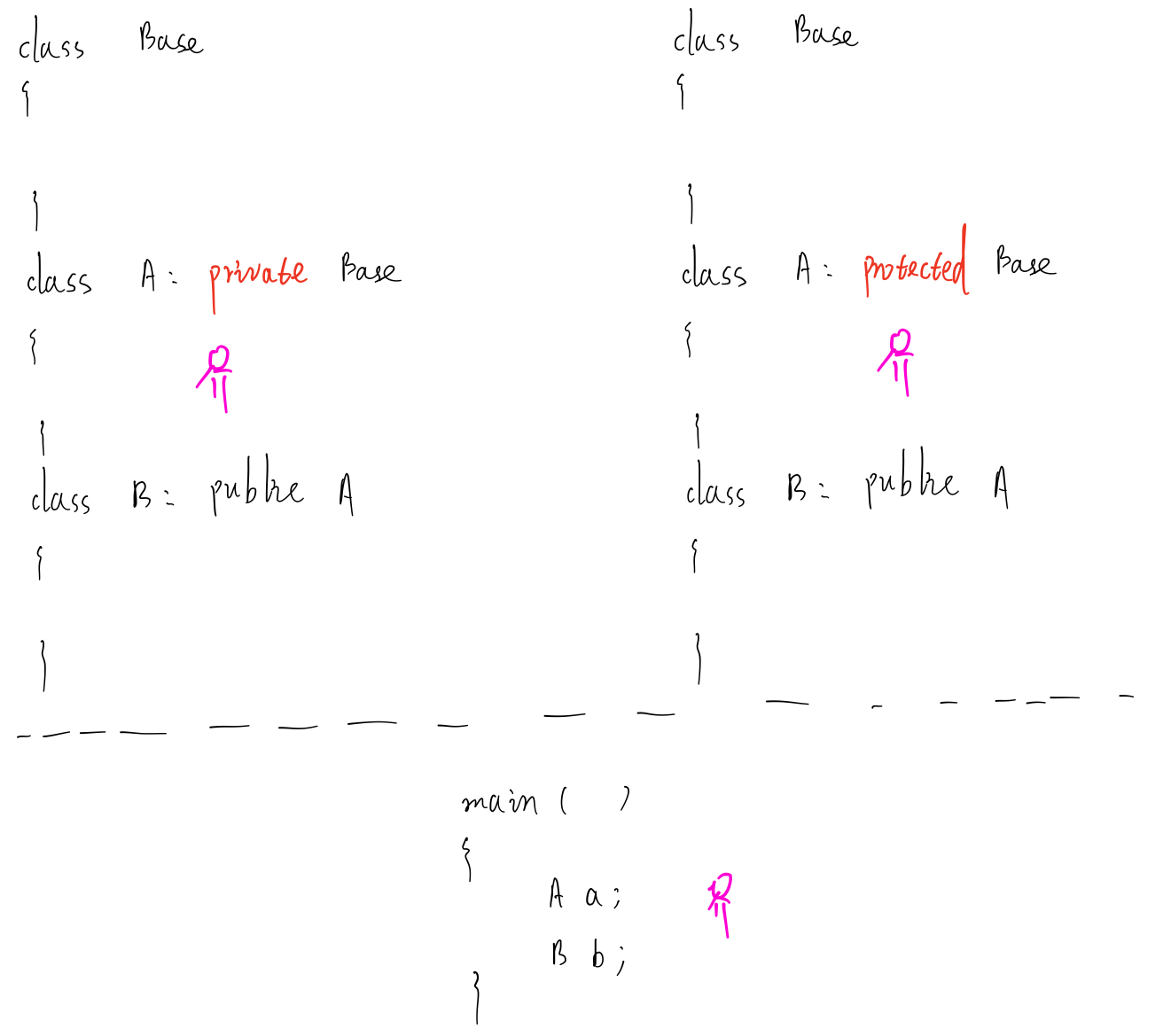
对于继承关键字,我门只需要写一次,但是用的时候却要看2次。见上图2个小人,一个看子类内部通过继承关键字如何看代父类。一个是子类对象通过继承关键字如何看代父类。
不管使用何种继承方式,父类私有数据成员,子类内部都是不能直接访问的。可以通过父类的共有方法间接访问父类私有数据。这里有一点需要注意,假如是private继承父类,父类里面protected数据或方法、public数据或方法、private方法都是可以直接访问的。 这时候如果站在子类内部那个小人的角度看问题,private和protected表现行为差不多。那protected和private区别在哪?
区别在孙子类那里,如果是private继承,Base父类在儿子A那里都是私有的,到了孙子B那里父类无论是数据还是方法都访问不了了。相当于private关键字割断了继承关系,整个继承家族到儿子辈就绝后了。如果是protected就可以保障继承关系不断。
private指定的属性 或 方法,将不能被继承。
protected指定的属性 或 方法,将在类外部不可见,但可以被继承。
派生类的构造函数与析构函数调用顺序
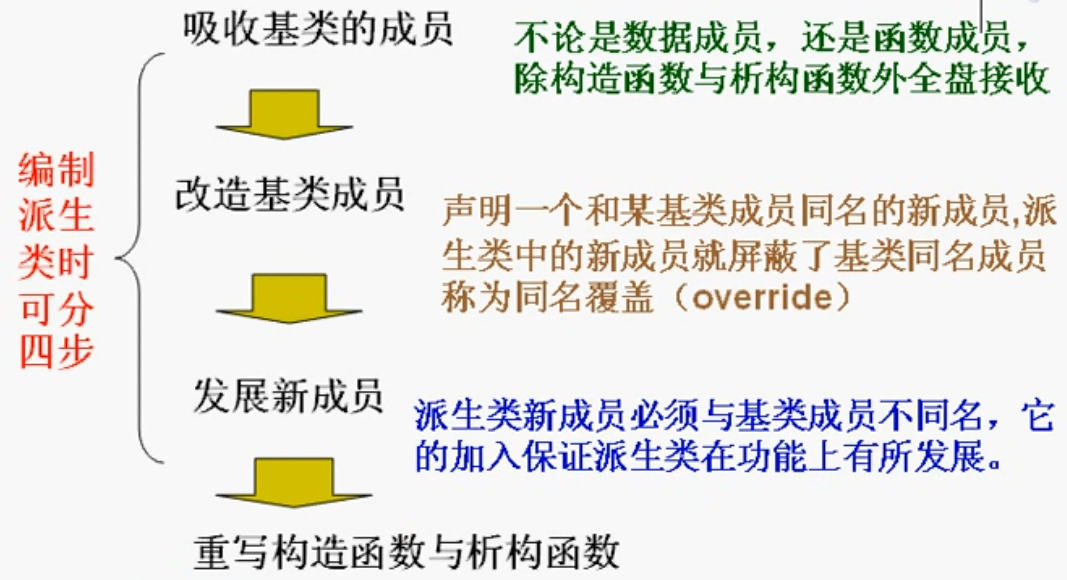
注:图片中 同名覆盖改为同名隐藏
#include<iostream>
using namespace std; class Base1
{
public:
Base1()
{
cout << "Create Base1" << endl;
}
~Base1()
{
cout << "Free Base1" << endl;
}
}; class Base2
{
public:
Base2()
{
cout << "Create Base2" << endl;
}
~Base2()
{
cout << "Free Base2" << endl;
}
}; class Base3
{
public:
Base3()
{
cout << "Create Base3" << endl;
}
~Base3()
{
cout << "Free Base3" << endl;
}
}; class D :public Base2, public Base1, public Base3
{
public:
D()
{
cout << "Create D" << endl;
}
~D()
{
cout << "Free D" << endl;
}
private:
Base1 b1;
Base2 b2;
Base3 b3;
}; int main(int argc, char *argv[])
{
D d;
return ;
}
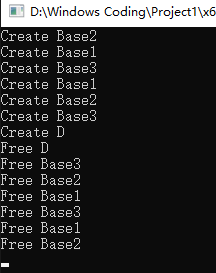
如果你继承的父类不提供默认或者缺省的构造函数,我们就必须使用参数列表的形式对父类进行构造。参数列表相当于再调用父类的构造函数。
千万不要把参数列表那里的父类构造函数放到子类构造函数里面,那样代表先完成子类构造再完成父类构造。爸爸还没生出来来,怎么会有儿子呢?
#include<iostream>
using namespace std; class Base1
{
public:
Base1(int d=):x(d)
{
cout << "Create Base1" << endl;
}
~Base1()
{
cout << "Free Base1" << endl;
}
private:
int x;
}; class Base2
{
public:
Base2(int d = ):y(d)
{
cout << "Create Base2" << endl;
}
~Base2()
{
cout << "Free Base2" << endl;
}
private:
int y;
}; class Base3
{
public:
Base3(int d = ):z(d)
{
cout << "Create Base3" << endl;
}
~Base3()
{
cout << "Free Base3" << endl;
}
private:
int z;
}; class D :public Base2, public Base1, public Base3
{
public:
D(int data):Base1(data), Base2(data), Base3(data),b1(data), b2(data), b3(data)
{
cout << "Create D" << endl;
}
~D()
{
cout << "Free D" << endl;
}
private:
Base1 b1;
Base2 b2;
Base3 b3;
}; int main(int argc, char *argv[])
{
D d();
return ;
}
参数列表那里的构造函数顺序任意写。决定构造函数顺序只有2处:①继承声明时的顺序②类内部数据成员的顺序。
对于多继承,某一数据成员可能在多个父亲中存在定义。在子类中访问父类数据成员时会存在二义性。下面代码演示,这段代码编译不过
#include<iostream>
using namespace std; class B1
{
public:
B1(int d=):n(d)
{}
~B1()
{}
public:
int n;
}; class B2
{
public:
B2(int d = ):n(d)
{}
~B2()
{}
public:
int n;
}; class D :public B2, public B1
{
public:
D():x()
{}
~D()
{}
private:
int x;
}; int main(int argc, char *argv[])
{
D d;
d.n=;
return ;
}
这种情况需要指明到底是哪个父类的数据成员
#include<iostream>
using namespace std; class B1
{
public:
B1(int d=):n(d)
{}
~B1()
{}
public:
int n;
}; class B2
{
public:
B2(int d = ):n(d)
{}
~B2()
{}
public:
int n;
}; class D :public B2, public B1
{
public:
D():x()
{}
~D()
{}
private:
int x;
}; int main(int argc, char *argv[])
{
D d;
d.B1::n=;
return ;
}
钻石继承
#include<iostream>
using namespace std; class B0
{
public:
B0(int d=):m(d)
{}
~B0()
{}
public:
int m;
}; class B1:public B0
{
public:
B1(int d = ):n(d)
{}
~B1()
{}
public:
int n;
}; class B2 :public B0
{
public:
B2(int d = ) :n(d)
{}
~B2()
{}
public:
int n;
}; class D :public B2, public B1
{
public:
D():x()
{}
~D()
{}
private:
int x;
}; int main(int argc, char *argv[])
{
D d;
d.B1::n=;
d.B1::m = ;
return ;
}
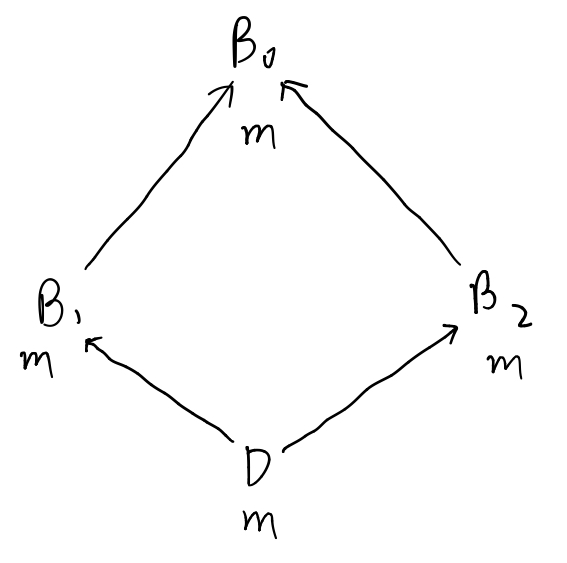

类B1,B2都有m,所以D中要想使用m必须指定具体是哪个类的m
使用virtual关键字,让整个钻石继承使用一个数据成员。这种继承叫虚拟继承
#include<iostream>
using namespace std; class B0
{
public:
B0(int d=):m(d)
{}
~B0()
{}
public:
int m;
}; class B1: virtual public B0
{
public:
B1(int d = ):n(d)
{}
~B1()
{}
public:
int n;
}; class B2 : virtual public B0
{
public:
B2(int d = ) :n(d)
{}
~B2()
{}
public:
int n;
}; class D :public B2, public B1
{
public:
D():x()
{}
~D()
{}
private:
int x;
}; int main(int argc, char *argv[])
{
D d;
d.B1::n=;
d.m = ;
return ;
}
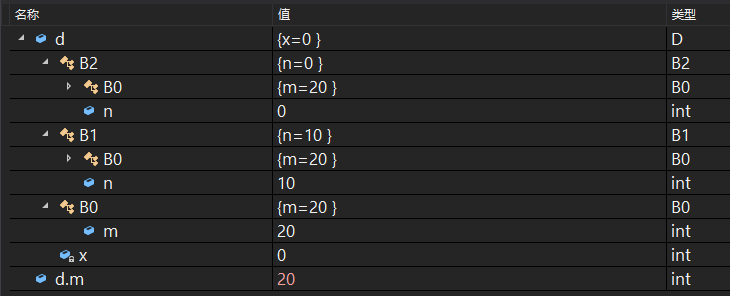
在派生类对象的创建中,首先是虚基类的构造函数并按它们声明的顺序构造。第二批是非虚基类的构造函数按它们声明的顺序调用。第三批是成员对象的构造函数。最后是派生类自己的构造函数被调用
#include<iostream>
using namespace std; class Base1
{
public:
Base1()
{
cout << "Create Base1" << endl;
}
~Base1()
{
cout << "Free Base1" << endl;
}
}; class Base2
{
public:
Base2()
{
cout << "Create Base2" << endl;
}
~Base2()
{
cout << "Free Base2" << endl;
}
}; class Base3
{
public:
Base3()
{
cout << "Create Base3" << endl;
}
~Base3()
{
cout << "Free Base3" << endl;
}
}; class D :public Base2, virtual public Base1, virtual public Base3
{
public:
D()
{
cout << "Create D" << endl;
}
~D()
{
cout << "Free D" << endl;
}
private:
Base1 b1;
Base2 b2;
Base3 b3;
}; int main(int argc, char *argv[])
{
D d;
return ;
}
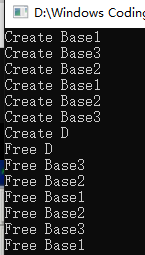
C++——Inheritence的更多相关文章
- JAVA 1.9 面向对象之封装
1. 面向对象程序设计的三大基本特征:继承(Inheritence).封装(Encapsulation).多态(Polymorphism)2. 封装:类包含了数据与方法,将数据与方法放在一个类中就构成 ...
- Java 编程入门(词汇表)
抽象类(abstract class):抽象类不能创建对象,主要用来创建子类.Java中的抽象类使用 abstract 修饰符定义. 抽象数据类型(abstract data type ADT):抽象 ...
- Java性能提示(全)
http://www.onjava.com/pub/a/onjava/2001/05/30/optimization.htmlComparing the performance of LinkedLi ...
- 常用CSS Reset汇总
什么是Css Reset呢? 在 HTML标签在浏览器里有默认的样式,不同浏览器的默认样式之间也会有差别.在切换页面的时候,浏览器的默认样式往往会给我们带来麻烦,影响开发效率.所以解决的方法就是一开始 ...
- Java SE 第九讲---面向对象特征之封装1
1.面向对象程序设计的三大基本特征:继承(Inheritence).封装(Encapsulation).多态(Polymorphism) 2.封装:类包含数据与方法,将数据与方法放在一个类中就构成了封 ...
- Java SE ---类,方法,对象等
1,面向对象程序设计的三大基本特征:继承(Inheritence).封装(Encapsulation).多态(Polymorphism) 2,如何定义类? 修饰符 cla ...
- 关于Java多态的总结.
[圣思源笔记]JAVA SE Lesson 11. 类是一种抽象的概念,对象是类的一种具体表示形式,是具体的概念.先有类,然后由类来生成对象(Object).对象又叫做实例(Instance).2. ...
- WINAPI 变量(2861个)
WINAPI 变量(2861个) 这是从 c:\Program Files\Windows Kits\8.1\Include\um\WinUser.h 这个文件 中提取的 CTRL+F 查看变量所 ...
- Windows API 常量定义
Windows 常量定义在winuser.h中可以找到,如果了安装了visual studio 2010,winuser.h所在目录为C:\Program Files (x86)\Microsoft ...
随机推荐
- Python第一阶段06
1.面向对象编程: class Dog: def __init__(self, name): self.name = name def bulk(self): print("%s 汪汪汪.. ...
- redis添加到linux系统服务
http://blog.csdn.net/justfor3l/article/details/53187795
- easyui datagrid 让某行复选框置灰不能选
easyui中datagrid 让某行复选框置灰不能进行选中操作,以下为主要部分的code. //加载完毕后获取所有的checkbox遍历 onLoadSuccess: function(data){ ...
- swift 日历的制作
制作日历步骤 1.日期数据的处理,这个可以 添加 extension 解决 extension NSDate{ /*几年几月 这个月的多少天*/ class func getDaysInMonth( ...
- Docker 安装运行MSSQL Server
1.镜像主页 https://hub.docker.com/_/microsoft-mssql-server 2.拉取2017最新版 docker pull mcr.microsoft.com/mss ...
- PHP LUHN算法验证银行卡
<?php /* 16-19 位卡号校验位采用 Luhn 校验方法计算: 第一步:把信用卡号倒序(61789372994) 第二步:取出倒序后的奇数位置上的号码, 相加等到总和s1.(eg:s1 ...
- zend framework多模块多Layout配置
转自: http://blog.csdn.net/a82168506/article/details/10228011 上次接触zend framework已经很久远了,10年的事情了.最近在做一个项 ...
- PAT甲级题分类汇编——计算
本文为PAT甲级分类汇编系列文章. 计算类,指以数学运算为主或为背景的题. 题号 标题 分数 大意 1058 A+B in Hogwarts 20 特殊进制加法 1059 Prime Factors ...
- Arraylist的遍历方式、java反射机制
先定义ArrayList再添加几条数据: ArrayList arr=new ArrayList(); //往arrList中增加几条数据 arr.add(1); arr.add(2) ...
- jdk8新特性--使用lambda表达式的延迟执行特性优化性能
使用lambda表达式的延迟加载特性对代码进行优化:
